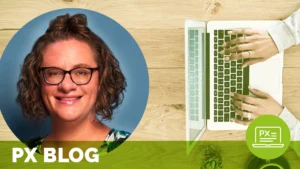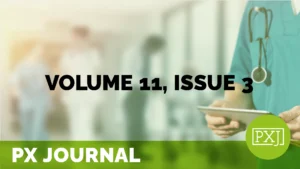Storytelling with a Purpose

By Rosie Bartel
Is your Patient and Family Advisory Council (PFAC) unsure how to regroup after COVID? Worse yet, has your organization lost its PFAC completely? If so, this is a perfect time to look at the role of a Patient and Family Advisor (PFA) in new ways. As you begin to rebuild or reboot your PFAC, there are several important objectives to consider, but today I want to focus on just one: Co-design.
Co-design in healthcare involves the equal partnership of healthcare staff and the individuals who have lived experience of using the health system, such as patients, families and caregivers, along with the ‘designers’ of a new process or procedure. When regrouping after COVID, first consider where members will be able to co-design or co-produce across the healthcare organization. This entails more than just attending a meeting once a month to give feedback about issues brought to the PFAC. The best way for PFAs to engage in co-design and co-production is by embedding them into every area of the organization, from the Board of Directors to the Security Department.
As a PFA who has worked with several departments at different healthcare organizations, I can tell you this is the only way to co-design or co-produce. It is the best way to use your story to make a difference for all patients and families. I call it “storytelling with a purpose.” I use my story to help drive quality improvement, advance research and enhance the use of measurement data, depending on the healthcare setting I am working in. I am not a once-and-done PFA. I am a person who believes a PFA should get involved right from the start of a new project and be consulted throughout the design phase.
The question a PFA needs to ask when a healthcare organization seeks them out is, “What are the areas or departments available at this time to work with me as a PFA?” If they can’t answer that question, this might indicate the PFAC is not ready for co-design or co-production. I would look at this as an opportunity to help them redesign their PFAC to reevaluate their purpose, goals and objectives.
How can a PFA help design a PFAC for co-design or co-production? One healthcare organization that I worked with did this by using “the back door.” I started working as a PFA with the Facilities Department, which included maintenance, security, new or renovation construction, and environmental services. During this assignment, my voice was equal to everyone else on their teams at their departmental meetings. I am still not a member of their PFAC, but that is OK, because this assignment allowed me the opportunity to be part of a team and set the path to a seat on their PFAC. You see, this organization looks at PFAC membership differently than most. When they invite a new member, they also invite them to participate as a team member for one of their departments. It is more than an invitation, but a requirement for membership on their PFAC.
My challenge to all healthcare organizations is that as you start, rebuild or reboot your PFAC, think about how the PFAs can co-design or co-produce advances in one or more departments in your organization. Embedding them into a variety of areas promises to change experience outcomes for many who will enter your doors in the future. Being a listening organization means intentionally and deliberately listening to and acting on the lived experience of patients and families. When PFAs inform an organization and go beyond just helping them, they can most meaningfully contribute to improvement, change and innovation in the experience of care. I encourage you to give PFAs this opportunity to engage in storytelling with a purpose.
Author Bio:
Rosie is a widow, mother, grandmother and an educator. In August of 2009 she underwent a total right knee replacement that developed into a MRSA staph infection. This healthcare-acquired infection has led to 58 surgeries, over 200 hospitalizations, 100 blood transfusions, a right leg amputation six inches above the knee, and a total hip amputation with the removal of part of her pelvic bone. Rosie has experienced sepsis and septic shock fourteen times in her health journey.
As she continues to battle this infection in her body, Rosie is driven to share her story of survival. Every day she uses her story to advise or advocate for others. She believes in helping patients and caregivers find their voices. As an educator, she has used stories to teach children and adults. Today, she uses her story to co-design with medical professionals and researchers and to advise and advocate for patients and their caregivers. She was a recent speaker at the International Forum on Quality & Safety in Healthcare in Copenhagen.
Related content
-
 Patient Family & Community Engagement
Patient Family & Community EngagementTailoring Communication for Families: Enhancing Understanding and Reducing Stress in Pediatric Care
By Emily Revelle Communication is the basis of all things we do in healthcare. When done well, it allows us to present vital information to the family, work well together as a medical team, and establish psychological safety. When done poorly, it will do the opposite and can increase mistrust of the medical system. What
Learn more -
 Patient Family & Community Engagement
Patient Family & Community EngagementA Passage of Advocacy and Listening: How My Name and Experiences Shaped My Purpose in Healthcare
By Typhany Morrison-Brooks I was born Madelyn Morrison without a middle name because my mother wanted me to have the space to choose one someday. I arrived a couple of months early, weighing just 4 pounds. They had already picked “Madelyn” for me, but as I lay in the incubator, I flipped myself over, earning
Learn more -
 Patient Family & Community Engagement
Patient Family & Community EngagementPatient, Family, and Health Professional Perspectives of How Families are Involved in Adult Inpatient Traumatic Brain Injury Rehabilitation
Objective: We aimed to answer the following research question: From the perspectives of patients, family members, and health professionals, how are families involved in the rehabilitation of adult patients with Traumatic Brain Injury at an inpatient Acquired Brain Injury service within an adult rehabilitation centre? Methods: We used an interpretive qualitative approach, from a constructivist view.
Learn more
